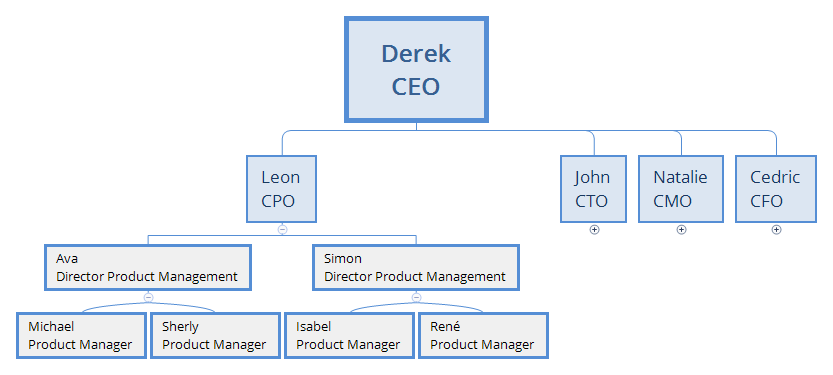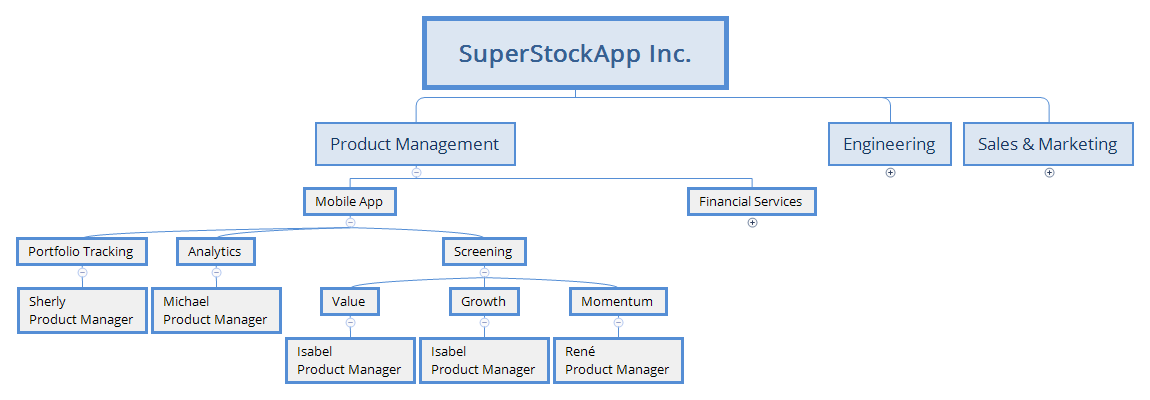Those that have entered big organizations in the past know the situation all too well: Who is responsible for what? How do I find the right contact for my issue? More often than not people are resorting to the org chart to figure out to whom they may need to reach out and the org chart usually is just a bookmark away. Unfortunately, the org chart is the most inappropriate way to find the answer that you are looking for because it was not designed as a solution for this problem. Therefore, it causes inefficiences and miscommunication. Do not feel ashamed if you have used it before, we all have. Most likely because there was no better alternative in place. In this post, let us explore one of the alternatives that is no more complex than an org chart but indeed delivers an efficient solution to the problem: find out who is the right responsible person for what you want to achieve, confirm, get clarified.
Let us illustrate the problem using a made up but realistic example that this blog will often make use of: SuperStockApp Inc. is the company behind the SuperStockApp for Android and iOS, one of the leading investing tools in the market with focus on ease of use yet powerful analytics and screening capabilities. A common problem that arises when people communicate based on past knowledge, i.e. reach out to colleagues that they used to reach out to in the past, or based on the org chart, i.e. reach out to who they think is responsible based on their position in the org chart, is that the person is not the right person. They get invited to the wrong meetings, they get added to Slack groups that they do not need to be in, they get asked questions that they should not answer, and when they sometimes do answer to be polite, the answer may not be as accurate as if the right contact would have answered it. All of that lead to inefficiences at best and miscommunication at worst. Let us look at an extract from SuperStockApp’s org chart:

In this org chart, the job titles are very generic on purpose, but in many organizations you will find that job titles can be more specific, already hinting at a certain functional area, for example Product Manager Mobile App, Product Manager Financial Data, Backend Engineer, or Frontend Engineer to name a few, which makes the org chart even more appealing to look for an answer that it is not designed to deliver. The purpose of the org chart is to define who is reporting into whom and how the organization is structured into departments and teams but that does not define responsibilities in the same way. There is obviously an overlap. A Product Manager Mobile App is surely not responsible for the Financial Data product in the company, but still it does not tell you anything about the area of responsibility within the Mobile App product space. It is important to understand that the area of responsibility is always defined within the team. Responsibilities can even change more often than the reporting lines change. This is because as teams work together while the product is evolving and the company is growing, there is often a need to restructure within the team. A new hire may come in, tasks may get offloaded from one PM to another, PMs may switch from one product team to another within the same company. Whenever the team decides to reassign responsibilites to improve their ways of working, that does not necessarily cause the org chart to change. What is a better representation then? Let us look at a different chart that at first glance seems to look like an org chart as well with its tree-like structure but, looking closer, the tree does not define reporting lines but areas of responsibilities instead:

This chart is called Functional Responsibility Chart as it defines, as the name suggests, functional responsibilities that people have. Only the leaf nodes in this tree chart denote people, all other intermediate nodes describe the area of responsibility, the deeper in the tree a node is the more precise the area of responsibility it defines. In this example, Product Management is split into two major product lines Mobile App and Financial Services, and Mobile App further bifurcates into the functional areas Analytics, Portfolio Tracking and Screening. To add more complexity to it, which you will surely find in bigger organizations, the Screening area is further segregated into Value, Growth and Momentum screening approaches. It is only at the end of any path in this tree that you will find the Directly Responsible Individual (DRI) for the functional area denoted along the path. There are several points worth noting: First, a single person may appear multiple times in the functional responsibility chart. In this example, Isabel is the PM for both Value and Growth Screening approaches that the mobile app offers to its customers, whereas Momentum approaches are managed by the PM René. Second, not every individual of the org chart will appear in the functional responsibility chart because not every person needs to be exposed as an interface to other teams. Indeed, it needs to be avoided that people contact other people that may be in the know but are not expected to spend a majority of their time in interaction with others. Take senior engineers in bigger organizations as an example that have been with the company for many years. Those people have amassed a great deal of knowledge and hence might be interesting candidates to go to for quickly obtaining a solution to a critical problem. However, by circumventing the DRI the engineers are distracted from the work already assigned to them and their involvement may cause important work of a current sprint to be impacted. This occurs time and time again and, truth be told, it may even happen if a functional responsibility chart is in place. But it surely will happen more often than not if a functional responsibility chart is not in place.
Unlike the org chart, if you are now in need of expert advise on a specific topic, finding the area of responsibility in the functional responsibility chart will immediately point you to the DRI. For this approach to work over time, it is important that the functional responsibility chart is maintained in a central location just like the org chart which is maintained in a central location by the HR team. The functional responsibility chart also obsoletes any team-specific solution such as a responsibility matrix on the team’s Confluence page, especially as each team will likely have their own style in presenting maintaining this information, and it will likely be scattered across the organization’s intranet and not necessarily easy to find. When implementing a functional responsibility chart, a centralized solution is key as well as regular updates to the chart whenever a team decides to reassign the areas of responsibility within their team. To achieve this, a process needs to be well defined, well documented and regularly communicated to all managers within the organization so that everybody is aligned on how to keep the functional responsibility chart up-to-date. Only then this approach will be successful and enable your organization to avoid inefficiencies and miscommunication.
For those of you who rather want to watch than read this article, just watch the following TikTok:
